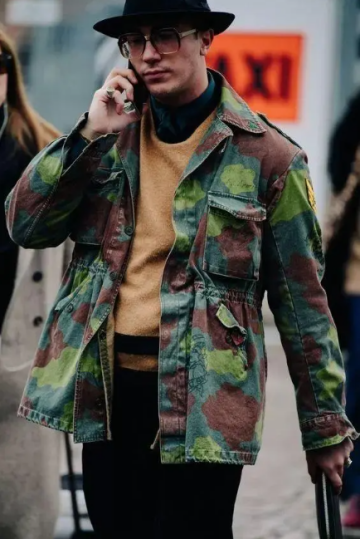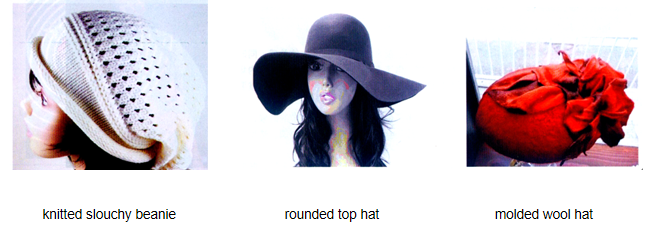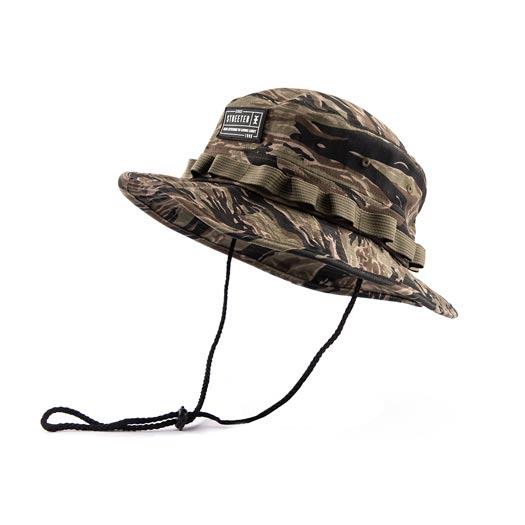Army Bucket Hat with Camo Patterns
Published On: November 27, 2023 By: kailyn

Intro
The Army Bucket Hat with camo patterns from Streeter- A great hat for all outdoor adventures. Streeter is one of the brands from Aung Crown. Aung Crown – a professional hat maker since 1998.
Camouflage Pattern
Men, in general, are apprehensive about wearing anything that has a printed pattern on it because they believe that the most practical alternative is to stick to solid colors. Why? The only real problem is that the vivid printing style may be too dazzling for a toddler, as well as the possibility that the pattern may be too simple for a child. Nevertheless, despite the wide variety of alternatives available, guys almost always opt for the tried-and-true pattern of camouflage.

The History of Camouflage
During World War I, the French army commissioned artists to paint artillery and observation posts to look like patterns in the forest. It is believed that the term camouflage originated from the Parisian slang term camoufler, which was used to describe those artists (meaning “to disguise”). Since that time, military organizations from over the world have come up with hundreds of different camouflage patterns in order to provide their soldiers with an advantage in combat.
The popularity of Camouflage
Camouflage became popular among civilians as a result of veterans of the Vietnam War who protested by wearing their military fatigues in public. This helped to promote the trend. Camouflage began to appear in the collections of fashion designers like Tommy Hilfiger and Yves Saint Laurent toward the end of the 1980s.
Camouflage is used by the military with the intention of remaining undetected; but, in the world of fashion, the objective is to stand out. In the urban jungle, the edgy combination of fractal greens, browns, and grays made a striking statement, yet on the battlefield, the chaotic pattern that faded away was impossible to ignore. The marketing brochures of a company frequently use the generic term “camo” to refer to the company’s fabrics, despite the fact that the company’s fabrics come in an extremely wide variety of patterns, colors, and textures.
Camouflage in World War II
During World War II, British paratroopers created brushstroke camouflage by physically painting their khaki uniforms with swathes of different colors using enormous brushes. This was done in order to conceal themselves better. This homemade pattern was a big hit with British special forces in the 1960s because it allowed individual soldiers to customize their gear to better suit their own requirements.

Camouflage Types
1. Brushstroke pattern
TThe Brushstroke pattern inspired the Tigerstripe design created by Vietnamese painters in the 1960s. Initially, it imitated the style of French colonists but became popular among Vietnamese Marines. It had its origins as a local copy of the style worn by French colonists.
Tigerstripe’s stripes worked well in Southeast Asia’s bamboo-rich rainforest. As a result, American special forces started wearing the same patterns by the end of the war. This was owing to the fact that Tigerstripe’s colors were black, brown, and green. With its Fall/Winter 2013 collection, the French fashion house A.P.C. was bringing the pattern full circle.

2. Duck Hunter
Duck Hunter, previously known as US M1942, was the camouflage worn by American soldiers in the Pacific Theater of World War II. It quickly became a favorite among soldiers.

3. Forest pattern
A forest pattern, inspired by the natural colors of leaves, grass, twigs, and branches, was designed by the United States Army Engineer Research and Development Laboratory (ERDL) in 1948. In the latter part of the 20th century, all camouflage designs were built upon the ERDL pattern. One notable descendant of ERDL is the United States Woodland camouflage.

4. Woodland
Thinking of camouflage, it’s likely that the Woodland design used by the United States comes to mind initially. The design with four colors is simply an ERDL with a 60% increase in size. Thinking of camouflage, it’s likely that the Woodland design used by the United States comes to mind initially. Even in modern times, around one-quarter of the armies in the world continue to make use of it.

5. Flecktarn
In the mid-1970s, the West German Army organized a competition for designers. The winning design, known as Flecktarn, was selected as the official uniform pant for all German soldiers. The leopard-like design became popular across Europe in the same way that Woodland did in North America. Many European designers, who strive to set themselves apart, feel that the Flecktarn pattern has become too common. However, in North America, the pattern still holds its appeal.

6. Six-color pattern or Chocolate chip
In 1981, the United States Army designed a six-color pattern that came to be known as the “Chocolate Chip.” This pattern is named after the rocky effect created by the black patches, resembling flecks of cookie dough. Several nations, such as South Korea, Iraq, and all of Africa, have adopted this technique as their main approach for desert warfare.

7. Splinter pattern
During World War II, the German Air Force developed the concept of the angular and geometric patterns known as the splinter pattern. This pattern creates images that resemble shattered glass. The pattern might remind you of something that would be printed on a shower curtain sold by Ikea. After the war, the Luftwaffe design was gradually removed from military service. Nevertheless, the influence of Bauhaus in its design has made it highly sought after by minimalist manufacturers such as A.P.C.
The Start of Camouflage
Camouflage started making its way into the arts and fashion in the early 20th century as a result of the work that Mare did during the First World War. When Picasso saw camouflage patterns being used on army trucks, he shouted, ” who made it, that is cubism.” Picasso was referring to the art movement.
The anti-war demonstrations that took place in the United States during the 1960s and 1970s in response to the Vietnam War served as a major inspiration for the widespread adoption of military camouflage patterns for use in civilian clothing.
Camouflage – Fashionable Element
Camouflage has become a staple in both high fashion and the high street since then. It has made appearances on the catwalks of renowned designers like Gucci and Christopher Kane. Initially, camouflage as a design element was exclusively reserved for menswear. However, this trend has now extended to women’s and children’s clothing as well.
This print is versatile and can be used for various items, including pinafores, skirts, utility jackets, and combat pants. Camouflage is increasingly being used as a fabric for interior decoration. It is an excellent choice for items like duvet covers, curtains, and throw cushions.
Streeter
Streeter, the hat manufacturer, decided to include camouflage in their bucket hats. This choice is not surprising considering the popularity of camouflage in the fashion industry and the wide range of camouflage patterns available. Bucket hats serve multiple purposes and can be worn for both aesthetic and practical reasons, especially when exploring the outdoors. The diverse functions of these hats are evident in their construction, both in terms of style and materials.
Army bucket hat – a must-have item for outdoors
When it comes to assembling our outfits, most of us opt for accessorizing with a vibrant fisherman’s hat. This keeps things straightforward while still making an impression. A dark or camouflage bucket hat, often known as an army bucket hat or a military bucket hat, is a popular and practical choice for professional outdoor training and activities.
You may also hear these hats referred to as military bucket hats. On the bright side, if you practice while wearing one of these bucket hats, it will help you pass yourself off as another person. Participating in group outdoor activities will, on the other hand, give the impression that you are more robust and professional if you are wearing camouflage.

Army Bucket Hat from Streeter
From this picture, are you able to determine the particular camouflage patterns that were employed on this bucket hat? It’s possible that Flecktarn should be the one to claim ownership of this item. It is constructed out of twill, which is a robust and adaptable fabric.
When you put on your go-to pair of denim jeans and relax on the sofa, you are probably donning a fabric that is woven from the flexible twill yarn. This weave generates characteristic diagonal lines by moving the position of the warp threads during the weaving process. Will because of its durability and ability to hide stains, twill is used to make a wide variety of clothing and accessories, including jeans, chinos, furniture coverings, backpacks, and more.

The Design of the Army Bucket Hat
In contrast to the majority of other emblems, the one on the bucket hat does not feature any embroidery. In addition to that, the label is made of a rubber patch. Because rubber can only be used to transmit a sophisticated vibe, the tag on the bucket hat, which is made of rubber, adds a one-of-a-kind textured aspect to the hat.
The ornate belt on the hat, which is a circle of military green, is there to add a dash of vivacity and comedy to an otherwise solemn ensemble. With the assistance of a hat with a flat brim, you may protect the sensitive areas of your face and neck from becoming sunburned.
By utilizing a windbreak rope and ensuring that your headgear is secure, you will be able to get the most out of your time spent outside. The idea that camouflage patterns are better suited to men than they are to women is a frequent fallacy; may women also wear them? You may relax knowing that our bucket hat is gender-neutral and can be worn by either men or women.
Perfect color-contrasting
Our standard headwear consists of camouflage bucket hats that are designed to match and coordinate with one another. And if you’re going for a chiller atmosphere, your best bet is to choose complementary colors that go well together. In the end, providing them with an entire set of camouflage decorations will not only make them feel more professional but will also come as a bit of a surprise to them.

In the End
Camouflage is becoming increasingly popular as a fashion choice in response to current cultural trends. Additionally, elements of camouflage are commonly combined with those of other patterns, which results in continually developing styles of camouflaged clothing. I can’t see a person who has a strong sense of style turning down the opportunity to wear this stylish army bucket hat. So, please try this army bucket hat from Streeter.
